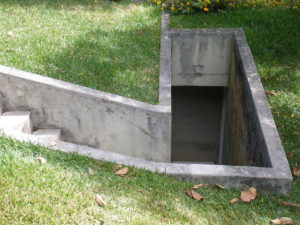Tornado Shelters
Tornados occur more frequently in the United States of America than in any other country. Tornados bring with them destruction of property and loss of lives. Tornado shelters are shelters built to provide refuge to people during a tornado. The destructive force of tornados is derived from the fast-moving winds and floating debris, which may move at speeds of up to 300 miles per hour.
 There are two categories of tornado shelters: above-ground storm shelters and below-ground storm shelters. Below-ground tornado shelters should not be built in areas that are prone to flooding. Knowledge of the soil conditions is also important as some soils will tend to collapse suddenly during tornado storms and the collapse may affect the structural integrity of the below-ground shelter. The soils may also apply pressure on the walls of the shelter. Below-ground shelters should therefore have strong walls to resist the lateral earth pressure. Below-ground tornado shelters should have water drainage systems and air supply systems to ensure that the occupants do not drown or run out of air.
There are two categories of tornado shelters: above-ground storm shelters and below-ground storm shelters. Below-ground tornado shelters should not be built in areas that are prone to flooding. Knowledge of the soil conditions is also important as some soils will tend to collapse suddenly during tornado storms and the collapse may affect the structural integrity of the below-ground shelter. The soils may also apply pressure on the walls of the shelter. Below-ground shelters should therefore have strong walls to resist the lateral earth pressure. Below-ground tornado shelters should have water drainage systems and air supply systems to ensure that the occupants do not drown or run out of air.
Above-ground shelters are ideal for flood prone areas. These tornado shelters allow for proper circulation of air and drainage of water during storms. These shelters may either be half-berm or full-berm. Half-berm shelters are shelters with half of its height below the ground level and half of its height above the ground level. Full-berm shelters have all their height above the ground level. Above-ground shelters may be constructed from existing rooms in a house by reinforcing the walls and providing for easy access and exit. Unlike below-ground shelters, above-ground shelters are subjected to high impact loads from debris and high suction pressure from the fast-moving wind. Therefore, the structural members in above-ground shelters are larger as compared to similar members in below-ground shelters. The effect of the larger members is a higher cost of construction.
 Both above-ground and below-ground tornado shelters have advantages and disadvantages. The main advantage of below-ground shelters is that they are protected from the large impact loads of debris and the high wind suction pressure that is characteristic in above-ground shelters. The disadvantage of below-ground shelters is that they may be prone to flooding, especially during intense storms. The main advantage of above-ground tornado shelters is that it allows for proper air and water circulation. The main disadvantage of above-ground shelters is cost. Half berm tornado shelters combine the benefits of both below-ground tornado shelters and above-ground tornado shelters, that is, proper anchorage and good air and water circulation.
Both above-ground and below-ground tornado shelters have advantages and disadvantages. The main advantage of below-ground shelters is that they are protected from the large impact loads of debris and the high wind suction pressure that is characteristic in above-ground shelters. The disadvantage of below-ground shelters is that they may be prone to flooding, especially during intense storms. The main advantage of above-ground tornado shelters is that it allows for proper air and water circulation. The main disadvantage of above-ground shelters is cost. Half berm tornado shelters combine the benefits of both below-ground tornado shelters and above-ground tornado shelters, that is, proper anchorage and good air and water circulation.
